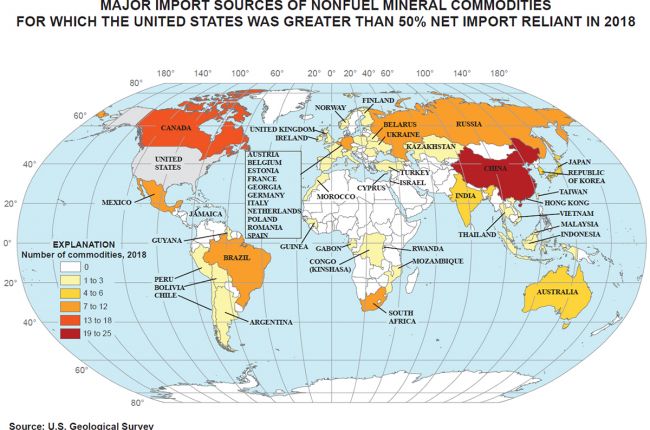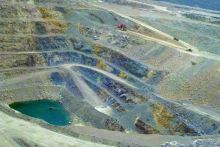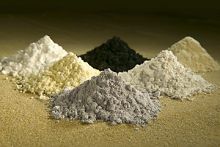
For many mineral commodities, the United States uses more than it produces. The balance between imports, exports, and use depends on many factors. These factors include resource availability, global economic markets, social and technological changes, production costs, resource demands, and trade agreements.1 Some minerals are more abundant or more cheaply produced in other countries. As a result, there are some mineral commodities that the U.S. does not produce domestically, making the country completely dependent on imports for these commodities. In 2018, the United States was completely dependent on imports for at least the following 18 mineral commodities:2
Arsenic, asbestos, cesium, fluorspar, gallium, natural graphite, indium, manganese, natural sheet mica, nepheline syenite, niobium, rare earths, rubidium, scandium, strontium, tantalum, thorium, and vanadium.
There are some mineral resources for which the U.S. is a net exporter. For these resources, the U.S. produces more than it consumes. In 2018, these included:2
Metallic abrasives, boron, clays, diatomite, gold, helium, iron and steel scrap, iron ore, kyanite, molybdenum concentrates, industrial sand and gravel, selenium, soda ash, titanium dioxide pigment, wollastonite, zeolites, and zirconium.
For other mineral commodities, U.S. production partly fulfils the country’s needs, and imports provide the rest. This balance is constantly changing as new resources are found, new technologies are developed, supplies and demands vary, economies grow or shrink, and political conditions shift. Because of this, the import, export, and use and movement of mineral commodities are continuously monitored by the National Minerals Information Center (NMIC) at the U.S. Geological Survey. Regularly updated datasets and information products are made publicly available, and summaries for all relevant mineral resources are published annually in the Mineral Commodity Summaries.
References
1 Policy – A Factor Shaping Minerals Supply and Demand U.S. Geological Survey
2 2019 USGS Mineral Commodity Summaries USGS National Minerals Information Center
Learn More:
- Tracking the Global Supply of Critical Materials (Webinar), American Geosciences Institute
2018 webinar detailing efforts from the U.S. and European Union to monitor the global production, trade, and usage of critical raw materials; identify and quantify vulnerabilities in supply; and support co-operation on production, recycling, and substitution of key mineral resources
- Policy – A Factor Shaping Minerals Supply and Demand (Report), U.S. Geological Survey
2002 report on the impacts of policy on the minerals economy on national and global scales.
- USGS Mineral Commodity Summaries (1996-present) (Website), U.S. Geological Survey - National Minerals Information Center
Annual mineral commodity summaries for all minerals tracked by the National Minerals Information Center since 1996.
- Publications and Data Products (Website), U.S. Geological Survey - National Minerals Information Center
Web portal for all publications and data products produced by the National Minerals Information Center
- Comparison of U.S. Net Import Reliance for Nonfuel Mineral Commodities - A 60-Year Retrospective (1954-1984-2014) (Factsheet), U.S. Geological Survey
2015 factsheet describing how U.S. import reliance has increased since the 1950s, and showing how the countries on which the U.S. relies for mineral imports have changed or become more or less important.


